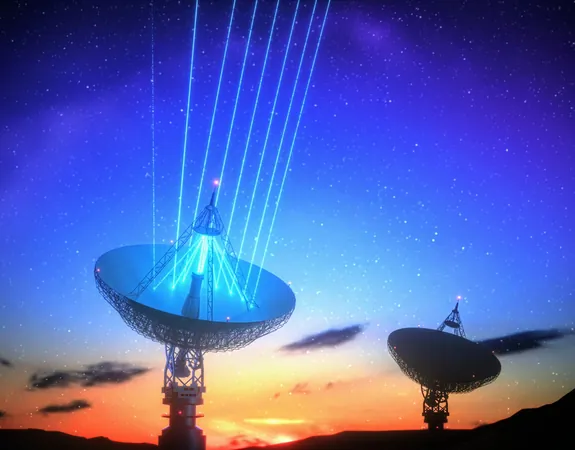
Mysterious Deep Space Radio Burst Detected from an Unexpected 'Dead Galaxy' – Scientists Stunned!
2025-01-23
Author: John Tan
Groundbreaking Discovery
In a groundbreaking discovery, scientists have detected a fast radio burst (FRB) emerging from a region considered a 'dead galaxy.' FRBs are brief, intense flashes of radio waves, lasting only milliseconds, and were first identified in 2007. Despite the detection of thousands since, the exact origins of these bursts have eluded researchers, leaving many questions in their wake.
The Source of FRBs
Fast radio bursts are typically found in distant galaxies, making their sources particularly difficult to pinpoint. However, last summer’s unusual emissions from the northern constellation Ursa Minor caught astronomers' attention. Preliminary investigations suggested these radio signals originated from a location far from our own Milky Way.
Key Findings by Researchers
A team led by astronomer Calvin Leung, a postdoctoral fellow at UC Berkeley, successfully utilized advanced computer algorithms to track these signals accurately. What they discovered was astonishing: the FRB source was located on the distant outskirts of an ancient elliptical galaxy—about 2 billion light years from Earth. This particular galaxy, estimated to be around 11.3 billion years old, raises one crucial question: how could a young, magnetized neutron star, likely the source of the bursts, exist in such an old, 'dead' galaxy?
Lack of Star Formation
Upon focusing optical telescopes on the burst's location, researchers were surprised to find the galaxy lacking the active star formation areas typically responsible for producing such energetic phenomena. Vishwangi Shah, a graduate researcher at McGill University, emphasized the importance of this finding, stating it is not only the first FRB to be captured from outside an inactive galaxy but also the farthest from its associated galaxy compared to all known FRBs.
Enhancements in Detection
Following the exciting breakthrough, researchers turned to the Canadian Hydrogen Intensity Mapping Experiment (CHIME), which has been instrumental in capturing a large number of these bursts. The addition of new partner stations, known as outriggers, is expected to enhance CHIME's ability to pinpoint bursts with unprecedented accuracy.
New Facilities
Additionally, a new facility at Hat Creek Observatory in Northern California has come online, further expanding astronomers' capabilities to explore these cosmic phenomena. With improved tools, they can now examine whether FRBs originate from star clusters or other distinct galactic structures.
Implications for Understanding FRBs
The implications of FRB 20240209A extend beyond mere scientific curiosity. Its detection in a 'dead galaxy' challenges conventional beliefs about where these bursts can occur, suggesting that such exotic events could arise from globular clusters, regions of dense, older stars surrounding a galaxy. If confirmed, this would mark a significant shift in our understanding of FRB origins.
Future Research Prospects
Experts remain eager to investigate how an ancient galaxy could experience powerful events typically linked to younger star-forming environments. Leung believes that advancements in technology, especially through CHIME and its additional telescopes, have the potential to exceed the observational capabilities of the Hubble Space Telescope and the James Webb Space Telescope, propelling FRB research into an exciting new phase.
Conclusion
The overall takeaway is clear: the mysteries of fast radio bursts are far from resolved. Our quest for knowledge about their causes and origins continues, driven by unrelenting curiosity and the pursuit of scientific understanding.
Stay Tuned!
Stay tuned—this may just be the tip of the iceberg! Is the universe hiding more secrets about these enigmatic bursts? Scientists are ready to dig deeper, and you won't want to miss what they uncover next!

 Brasil (PT)
Brasil (PT)
 Canada (EN)
Canada (EN)
 Chile (ES)
Chile (ES)
 Česko (CS)
Česko (CS)
 대한민국 (KO)
대한민국 (KO)
 España (ES)
España (ES)
 France (FR)
France (FR)
 Hong Kong (EN)
Hong Kong (EN)
 Italia (IT)
Italia (IT)
 日本 (JA)
日本 (JA)
 Magyarország (HU)
Magyarország (HU)
 Norge (NO)
Norge (NO)
 Polska (PL)
Polska (PL)
 Schweiz (DE)
Schweiz (DE)
 Singapore (EN)
Singapore (EN)
 Sverige (SV)
Sverige (SV)
 Suomi (FI)
Suomi (FI)
 Türkiye (TR)
Türkiye (TR)
 الإمارات العربية المتحدة (AR)
الإمارات العربية المتحدة (AR)